二十四节气(双语)
- 格式:pptx
- 大小:2.89 MB
- 文档页数:33
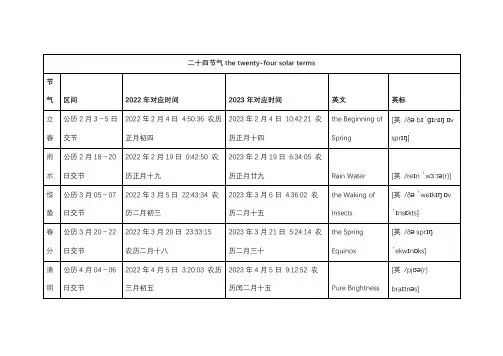
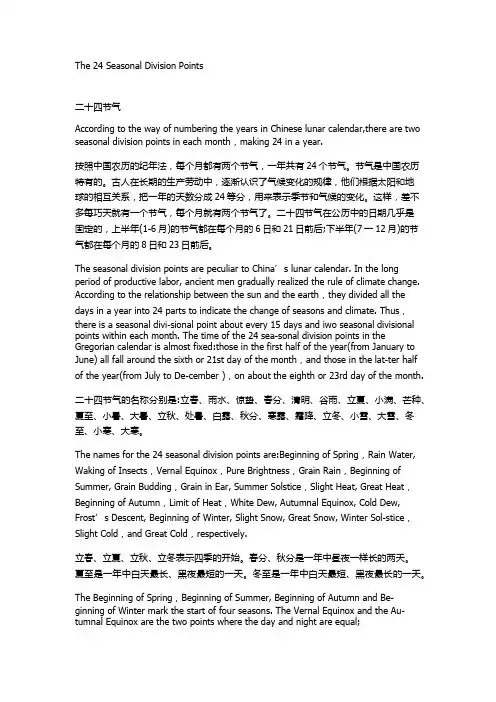
The 24 Seasonal Division Points二十四节气According to the way of numbering the years in Chinese lunar calendar,there are two seasonal division points in each month,making 24 in a year.按照中国农历的纪年法,每个月都有两个节气,一年共有24个节气。
节气是中国农历特有的。
古人在长期的生产劳动中,逐渐认识了气候变化的规律,他们根据太阳和地球的相互关系,把一年的天数分成24等分,用来表示季节和气候的变化。
这样,差不多每巧天就有一个节气,每个月就有两个节气了。
二十四节气在公历中的日期几乎是固定的,上半年(1-6月)的节气都在每个月的6日和21日前后;下半年(7一12月)的节气都在每个月的8日和23日前后。
The seasonal division points are peculiar to China’s lunar calendar. In the long period of productive labor, ancient men gradually realized the rule of climate change. According to the relationship between the sun and the earth,they divided all the days in a year into 24 parts to indicate the change of seasons and climate. Thus,there is a seasonal divi-sional point about every 15 days and iwo seasonal divisionalpoints within each month. The time of the 24 sea-sonal division points in the Gregorian calendar is almost fixed:those in the first half of the year(from January to June) all fall around the sixth or 21st day of the month,and those in the lat-ter half of the year(from July to De-cember ),on about the eighth or 23rd day of the month. 二十四节气的名称分别是:立春、雨水、惊蛰、春分、清明、谷雨、立夏、小满、芒种、夏至、小暑、大暑、立秋、处暑、白露、秋分、寒露、霜降、立冬、小雪、大雪、冬至、小寒、大寒。
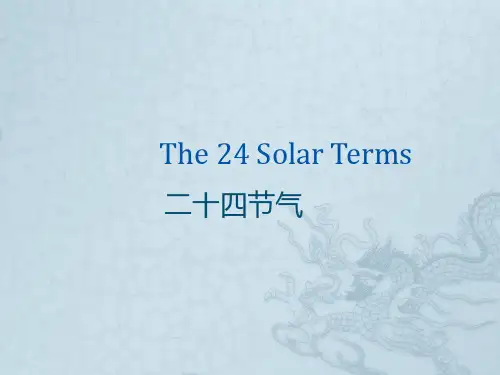

二十四节气表和具体时间中英文
二十四节气表和具体时间(中英文)
中国“二十四节气——中国人通过观察太阳周年运动而形成的时间知识体系及其实践”是中国人通过观察太阳周年运动,认知一年中时令、气候、物候等方面变化规律所形成的知识体系和社会实践。
在国际气象界,这一时间认知体系被誉为“中国的第五大发明”。
什么是二十四节气?
二十四节气的每个节气约间隔半个月的.时间,分列在十二个月里面。
在月首的叫做节气,在月中的叫做“中气”,所谓“气”就是气象、气候的意思。
2016年11月30
日,联合国教科文组织正式通过决议,将中国申报的“二十四节气——中国人通过观察太阳周年运动而形成的时间知识体系及其实践”列入联合国教科文组织人类非物质文化遗产代表作名录。
二十四节气指导着传统农业生产和日常生活,被誉为“中国的第五大发明”。
二十四节气表。
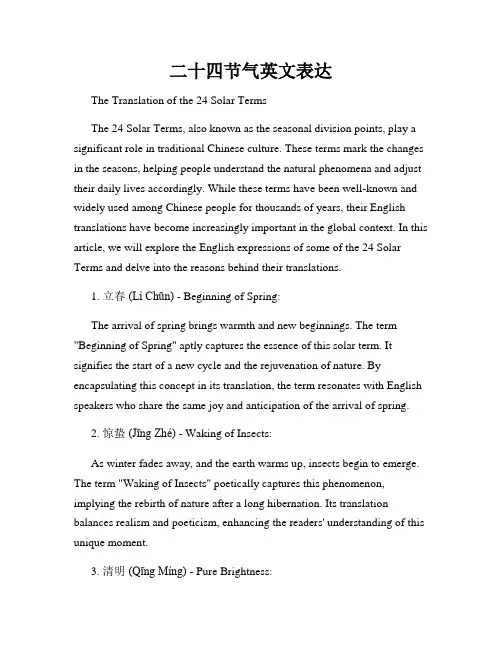
二十四节气英文表达The Translation of the 24 Solar TermsThe 24 Solar Terms, also known as the seasonal division points, play a significant role in traditional Chinese culture. These terms mark the changes in the seasons, helping people understand the natural phenomena and adjust their daily lives accordingly. While these terms have been well-known and widely used among Chinese people for thousands of years, their English translations have become increasingly important in the global context. In this article, we will explore the English expressions of some of the 24 Solar Terms and delve into the reasons behind their translations.1. 立春(Lì Chūn) - Beginning of Spring:The arrival of spring brings warmth and new beginnings. The term "Beginning of Spring" aptly captures the essence of this solar term. It signifies the start of a new cycle and the rejuvenation of nature. By encapsulating this concept in its translation, the term resonates with English speakers who share the same joy and anticipation of the arrival of spring.2. 惊蛰(Jīng Zhé) - Waking of Insects:As winter fades away, and the earth warms up, insects begin to emerge. The term "Waking of Insects" poetically captures this phenomenon, implying the rebirth of nature after a long hibernation. Its translation balances realism and poeticism, enhancing the readers' understanding of this unique moment.3. 清明(Qīng Míng) - Pure Brightness:In early April, the Pure Brightness solar term brings clear skies and bright sunshine. The term "Pure Brightness" reflects the essence of this period when nature is at its freshest, and everything appears clear and bright. Its translation conveys the visual imagery associated with this term, immersing the readers in the sense of tranquility and serenity that accompanies this season.4. 立夏 (Lì Xià) - Beginning of Summer:With summer approaching, the term "Beginning of Summer" precisely captures the transition from spring to summer. It symbolizes the onset of warmer weather, longer days, and a shift in daily routines. The translation resonates with English speakers who associate this time of the year with outdoor activities, celebrations, and vacations.5. 小满(Xiǎo Mǎn) - Grain Buds:During this period, crops begin to mature, and small grains appear on plants. The term "Grain Buds" effectively conveys the visual image of plants budding and crops thriving. The translation paints a vivid picture of fields filled with promise and abundance, enabling English readers to appreciate the importance of this seasonal milestone.6. 夏至 (Xià Zhì) - Summer Solstice:As the longest day of the year, the Summer Solstice brings heat and energy to the world. The term "Summer Solstice" encapsulates the astronomical significance of this solar term, making it universally understood across cultures and languages. Its translation allows Englishspeakers to relate to this exceptional day when the sun reaches its highest point in the sky.In conclusion, the translation of the 24 Solar Terms into English requires a careful consideration of cultural and natural elements. By capturing the essence of each term in its translation, we can bridge the gap between different languages and cultures, allowing people worldwide to appreciate and understand the beauty and significance of these seasonal milestones.。

二十四节气(中英双语)二十四节气(24 Solar terms)分别是:立春 Beginning of Spring,雨水 Rain Water,惊蛰Awakening of Insects (Waking of Insects),春分 Spring Equinox,清明 Pure Brightness,谷雨 Grain Rain,立夏 Beginning of Summer,小满Grain Buds (Grain Full / Lesser Fullness),芒种Grain in Ear,夏至 Summer Solstice,小暑 Minor Heat (Slight Heat),大暑 Major Heat (Great Hight),立秋 Beginning of Autumn,处暑 End of Heat (Limit of Heat),白露 White Dew,秋分 Autumn Equinox,寒露 Cold Dew,霜降 Frost’s Descent,立冬 Beginning of Winter,小雪 Minor Snow (Slight Snow),大雪 Major Snow (Great Snow),冬至 Winter Solstice,小寒 Minor Cold (Slight Cold),大寒 Major Cold (Great Cold)。
The 24 solar terms are specific festivals in the traditional Chinese Lunisolar calendars that represent changes in natural rhythms. There are four seasons of one year, three months each in Spring, Summer, Autumn, and Winter, with two solar terms per month; each solar term has its unique meaning. Solar terms were initially based on the rotation of the Big Dipper in ancient times. The modern definition uses ecliptic longitudes, which divide the annual motion path of the Sun into 24 equal parts, with 1 equal part every 15 ° and 1 equal part as a solar term, starting from the Beginning of Spring and ending in Greater Cold.二十四节气是日历中特定的节日,代表着自然节奏的变化。

中国24节气中英文对照中国古时流传下来的节气有24个,它们的英文翻译分别是?下面是店铺整理了一些中国24节气中英文翻译,希望对大家有帮助。
中国24节气中英文对照1. 立春 the Beginning of Spring (1st solar term)Feb.3,4, or 52. 雨水 Rain Water (2nd solar term)Feb.18,19 or 203. 惊蜇 the Waking of Insects (3rd solar term)Mar.5,6, or 74. 春分 the Spring Equinox (4th solar term)Mar.20,21 or 225. 清明 Pure Brightness (5th solar term)Apr.4,5 or 66. 谷雨 Grain Rain (6th solar teram)Apr.19,20 or 217. 立夏 the Beginning of Summer (7th solar term)May 5,6 or 78. 小满 Lesser Fullness of Grain (8th solar term)May 20,21 or 229. 芒种 Grain in Beard (9th solar term)Jun.5,6 or 710. 夏至 the Summer Solstice (10th solar term)Jun.21 or 2211. 小暑 Lesser Heat (11th solar term)Jul.6,7 or 812. 大暑 Greater Heat (12th solar term)Jul.22,23 or 2413. 立秋 the Beginning of Autumn (13th solar term)Aug.7,8 or 914. 处暑 the End of Heat (14th solar term)Aug.22,23 or 2415. 白露 White Dew (15th solar term)Sep.7,8 or 916. 秋分 the Autumn Equinox (16th solar term)Sep.22,23 or 2417. 寒露 Cold Dew (17th solar term)Oct.8 or 918. 霜降 Frost's Descent (18th solar term)Oct.23 or 2419. 立冬 the Beginning of Winter (19th solar term)Nov.7 or 820. 小雪 Lesser Snow (20th solar term)Nov.22 or 2321. 大雪 Greater Snow (21th solar term)Dec.6,7 or 822. 冬至 the Winter Solstice (22th solar term)Dec.21,22 or 2323. 小寒 Lesser Cold (23th solar term)Jan.5,6 or 724. 大寒 Greater Cold (24th solar term)Jan.20 or 224节气的历史价值二十四节气既是历代官府颁布的时间准绳,也是指导农业生产的指南针,日常生活中人们预知冷暖雪雨的指南针。

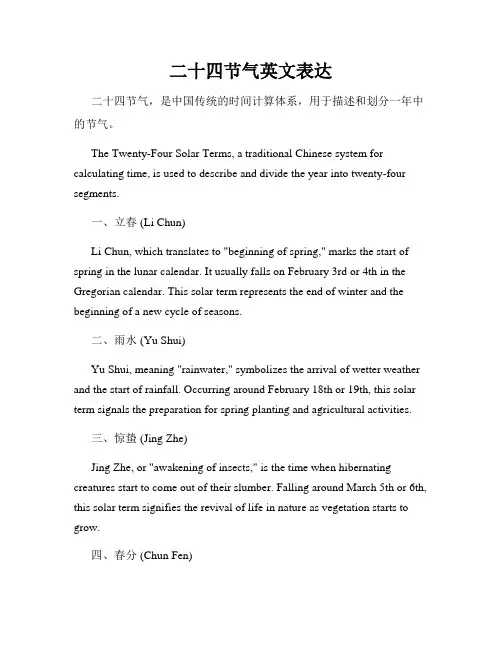
二十四节气英文表达二十四节气,是中国传统的时间计算体系,用于描述和划分一年中的节气。
The Twenty-Four Solar Terms, a traditional Chinese system for calculating time, is used to describe and divide the year into twenty-four segments.一、立春 (Li Chun)Li Chun, which translates to "beginning of spring," marks the start of spring in the lunar calendar. It usually falls on February 3rd or 4th in the Gregorian calendar. This solar term represents the end of winter and the beginning of a new cycle of seasons.二、雨水 (Yu Shui)Yu Shui, meaning "rainwater," symbolizes the arrival of wetter weather and the start of rainfall. Occurring around February 18th or 19th, this solar term signals the preparation for spring planting and agricultural activities.三、惊蛰 (Jing Zhe)Jing Zhe, or "awakening of insects," is the time when hibernating creatures start to come out of their slumber. Falling around March 5th or 6th, this solar term signifies the revival of life in nature as vegetation starts to grow.四、春分 (Chun Fen)Chun Fen, known as the "vernal equinox," occurs around March 20th or 21st. It is the midpoint between the winter solstice and the summer solstice. On this day, the length of day and night is approximately equal, symbolizing balance.五、清明 (Qing Ming)Qing Ming, often referred to as the "Tomb-Sweeping Day," falls on April 4th or 5th. It is a time for Chinese people to honor and remember their ancestors by cleaning their graves and offering sacrifices.六、谷雨 (Gu Yu)Gu Yu, meaning "grain rain," is the period when rainwater benefits the growth of crops. It usually occurs around April 19th or 20th, representing the important transition from spring to summer and the crucial time for sowing and cultivating crops.七、立夏 (Li Xia)Li Xia, the "beginning of summer," takes place around May 5th or 6th. With the rise in temperature, it officially marks the start of the hot summer season. People begin to adapt to the change in weather by adjusting their clothing and diet.八、小满 (Xiao Man)Xiao Man, known as "grain full," is the period when crops begin to mature. Falling around May 20th or 21st, this solar term signifies the critical stage in the growth of agricultural products and the forthcoming summer harvest.九、芒种 (Mang Zhong)Mang Zhong, or "grain in beard," represents the time when wheat and barley are ready to be harvested. It typically occurs around June 5th or 6th, indicating the start of summer agricultural work and the expectation of fruitful yields.十、夏至 (Xia Zhi)Xia Zhi, the "summer solstice," is the day with the longest daylight hours and the shortest night of the year. Falling around June 21st or 22nd, it marks the arrival of summer and represents the peak of heat.十一、小暑 (Xiao Shu)Xiao Shu, translated as "slight heat," is characterized by an increase in temperature. Taking place around July 7th or 8th, it signifies the hottest period of the year. People often indulge in various ways to cool down during this solar term.十二、大暑 (Da Shu)Da Shu, or "great heat," falls on July 22nd or 23rd, representing the hottest phase of summer. It is a reminder for people to take extra precautions against the extreme heat and to avoid heat-related illnesses.十三、立秋 (Li Qiu)Li Qiu, the "beginning of autumn," usually occurs around August 7th or 8th. As summer gradually wanes, this solar term marks the transition fromhot weather to cooler temperatures, with the appearance of occasional cold fronts.十四、处暑 (Chu Shu)Chu Shu, meaning "limit of heat," occurs around August 22nd or 23rd. It signifies the end of the hottest period and the start of a more bearable climate. During this solar term, people can finally enjoy some relief from the scorching summer heat.十五、白露 (Bai Lu)Bai Lu, known as "white dew," reflects the changing weather as dew starts to form in the mornings. Falling around September 7th or 8th, this solar term represents the gradual transition to autumn, with cooler temperatures and increased humidity.十六、秋分 (Qiu Fen)Qiu Fen, the "autumnal equinox," takes place around September 22nd or 23rd. Similar to Chun Fen in spring, day and night are approximately equal in length during this solar term, symbolizing harmony and balance.十七、寒露 (Han Lu)Han Lu, or "cold dew," occurs around October 8th or 9th. It is the time when the temperature further drops, leading to the formation of dew that can feel cold to the touch. This solar term signifies the arrival of cooler autumn weather.十八、霜降 (Shuang Jiang)Shuang Jiang, meaning "falling frost," falls around October 23rd or 24th. With the drop in temperatures, the first frost of the year usually appears during this period, indicating the further progression into autumn.十九、立冬 (Li Dong)Li Dong, the "beginning of winter," takes place around November 7th or 8th. As the crisp autumn air persists, this solar term signifies the arrival of colder temperatures and preparations for the upcoming winter season.二十、小雪 (Xiao Xue)Xiao Xue, translated as "light snow," falls around November 22nd or23rd. It represents the stage when the first sign of snowfall begins, albeit in the form of light flurries. This solar term marks the transition to colder weather.二十一、大雪 (Da Xue)Da Xue, or "heavy snow," typically occurs around December 7th or 8th. As winter tightens its grip, snowfall becomes heavier, covering the landscape in a thick blanket of white. This solar term symbolizes the arrival of the coldest period of the year.二十二、冬至 (Dong Zhi)Dong Zhi, the "winter solstice," is the shortest day and longest night of the year. Falling around December 21st or 22nd, it marks the official arrival of winter. People celebrate this solar term with family reunions and the consumption of traditional food.二十三、小寒 (Xiao Han)Xiao Han, meaning "light cold," falls around January 5th or 6th. As winter continues its course, the temperature drops even further. Despite the slight cold, this solar term also signifies that spring is gradually approaching.二十四、大寒 (Da Han)Da Han, or "great cold," takes place around January 20th or 21st. As the coldest period of the year, it represents the end of winter and the beginning of the next cycle of seasons. People take necessary precautions to stay warm during this extremely cold period.In conclusion, the Twenty-Four Solar Terms play a significant role in the Chinese traditional culture, observing the cyclical nature of time and the changes in weather throughout the year. These solar terms not only serve as a calendar system but also provide valuable insights into the agricultural practices and daily lives of the Chinese people.。